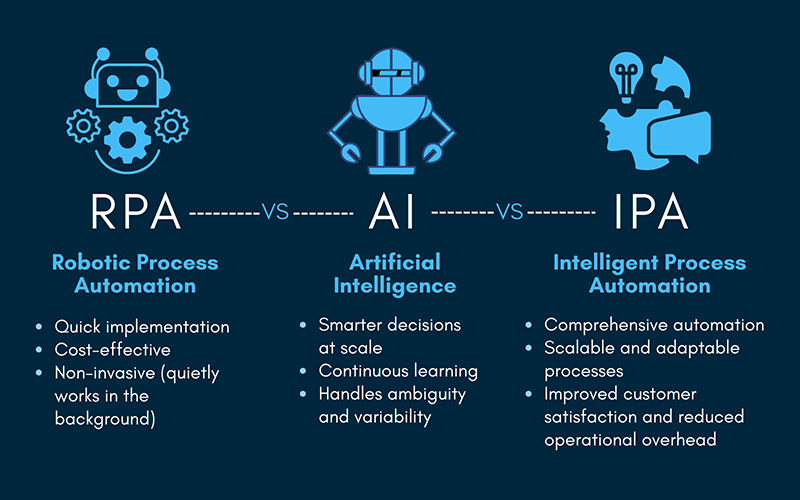Did you know more than half of the businesses that invest in automation end up wasting time, money and resources—all because they chose the wrong technology to solve their problem?
Automation technologies, now seen as a “digital pandemic” that has been transforming industries, and with buzzwords like AI (Artificial Intelligence), RPA (Robotic Process Automation), and IPA (Intelligent Process Automation) floating around, many decision-makers are left pondering the question: AI vs RPA vs IPA – Which one do I need?
The decision of when to choose to deploy an AI bot, when to let AI take charge of your workflow, or when to combine both into a powerhouse solution, can be the difference between a successful digital transformation solution and a halfway abandonment. Therefore, this post breaks it down for you with no technical jargon overload, just clarity.
Understanding the Basics
Before we delve into figuring out when to use what, let’s quickly explore what each technology is and isn’t:
- AI (Artificial Intelligence): AI doesn’t just follow instructions—it learns. It analyzes, predicts, organizes, and evolves. From chatbots that have contextual understanding capabilities to models that scan medical records for patterns, AI is all about enabling machines to think (or at least seem like they do).
- RPA (Robotic Process Automation): RPA is a technology that automates repetitive, rule-based tasks. Consider it a digital assistant that mimics human actions. It can log into systems, click buttons, copy-paste data, and follow predefined rules; just how a human would do. However, it doesn’t have the ‘thinking’ capabilities like AI.
- IPA (Intelligent Process Automation): In simpler terms, IPA is the lovechild of AI and RPA. It takes the robotic precision of RPA and blends it with AI’s brains. The result? A through-and-through automated system that can think and act. For instance, it might extract key insights from emails (AI) and then update a database with relevant details (RPA).
What Are the Differences Between RPA, AI, and IPA?
Well, let’s analyze it by use-cases, which will help you instantly relate these tech to the real-world scenarios.
- RPA – When “Repetitive Tasks” Is Your Staple
If your requirement involves rule-based, repetitive, structured tasks then RPA is your savior. RPA thrives in performing straightforward, simple tasks following established rules, involving nothing outside-the-box. It’s ideal for companies starting out in business process automation.
Ideal scenarios for RPA:
- Account setup in HR systems
- Invoice processing
- Copying data from one system to another
- Generating reports
Signs you need RPA:
- Your task is high-volume but less complicated
- The process doesn’t require interpretation
- You’re looking for a quick ROI without a full digital transformation
Pros of RPA:
- Quick implementation
- Cost-effective
- Non-invasive (quietly works in the background)
While RPA is the go-to tech for straightforward tasks, it falters when your tasks involve making decisions. If your process involves “if this, then maybe that” logic, you’re slowly stepping into AI/IPA territory.
- AI – When You Have to Think “Beyond the Rules”
AI thrives where logic and rules come to a complete dead end. If your task involves understanding, predicting or extracting patterns from unstructured data—you are now in AI territory.
Ideal scenarios for AI:
- Diagnosing conditions from patient health data
- Fraud detection using pattern recognition
- Customer sentiment analysis from emails or reviews
- Predictive analytics for sales or demand planning
Signs you need AI:
- You’re struggling to process unstructured data
- You need insights more than rule-based data
- You want a system that adapts and evolves with your workflow
Pros of AI:
- Smarter decisions at scale
- Continuous learning
- Handles ambiguity and variability
For example, DK AI’s AI-powered document processing doesn’t just scan medical forms; it understands them, and extracts relevant medical summaries for clinicians and insurers alike.
- IPA – When You Want the “Best of Both Worlds”
You’ve heard of how “teamwork makes the dream work.” At times, rules won’t suffice and pure AI isn’t practical unless it’s paired with action. This is where IPA or Intelligent Process Automation steps into the spotlight. It seamlessly combines RPA’s ability to act and AI’s ability to think and decide.
Ideal scenarios for IPA:
- Claim processing: Analyze insurance claims and extract relevant data to be entered into another system.
- Managing end-to-end workflows: Loan approvals, documents scanning and credit scoring.
- Handling customer queries: Translate the complex query, extract key insights and respond accordingly.
Signs you need IPA:
- You’re looking for end-to-end automation and not just task automation
- Your process is partly structured and partly not
- Your goal is to scale intelligently more than just efficiently
Pros of IPA:
- Comprehensive automation
- Scalable and adaptable processes
- Improved customer satisfaction and reduced operational overhead
More enterprises are now rapidly switching to IPA as it reduces silos between departments, solidifies workflow, and most importantly—thinks before and while it performs an action.
Choosing between RPA, AI and IPA
Here’s the truth: there’s no one-size-fits-all technology. The real question isn’t “Which is better?” but “Which is right for the problem I’m trying to solve?”
- Looking for a quick relief from copy-paste fatigue? Go with RPA.
- Need to understand customer feedback or identify patterns? Leverage AI.
- Want to redefine entire business processes intelligently? Adopt IPA.
Still not sure how to go forward? You’re not alone, and that’s where experts like DeepKnit AI can help you understand the difference between AI and Intelligent Automation.
Why Collaborate with DeepKnit AI?
- Custom-built Solutions: We understand that every business is unique, and so are their requirements. We design solutions according to your workflows, data and objectives—not someone else’s.
- Future-ready Systems: With a long-term focus on sustainable value, DeepKnit AI ensures your automation efforts are built to learn, adapt and evolve with your growing business needs.
- Deep Expertise across All Techs: Whatever your goal may be: automate rule-based admin work, train custom AI models, or implement IPA workflows that scale, we bring the right mix of strategy and execution.
Final Thoughts
Automation is no longer about replacing humans; it’s about augmenting them. The right technology at the right time can bring efficiencies you once thought weren’t possible.
So, the next time you’re faced with a repetitive process, an unstructured mess of data, or a convoluted workflow, take a pause and ask yourself: Is this a job fit for RPA, AI, or IPA?
And if you’re still not sure, don’t worry because DeepKnit AI is just a click away.
Confused among AI, RPA, and IPA?
Clear the mental fog with precision-engineered solutions by DeepKnit AI!
Try Now


